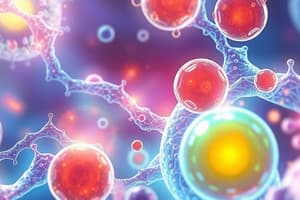Podcast
Questions and Answers
What is the basic structural, functional, and biological unit of life?
What is the basic structural, functional, and biological unit of life?
Cell
Who discovered the cell?
Who discovered the cell?
Robert Hooke
What does the term 'cellula' mean?
What does the term 'cellula' mean?
- Small room (correct)
- Large space
- Biological unit
- Living organism
Cells are the building blocks of life.
Cells are the building blocks of life.
What kind of organisms have eukaryotic cells?
What kind of organisms have eukaryotic cells?
What are the two main types of cells?
What are the two main types of cells?
The human body is built with about ___ trillion cells.
The human body is built with about ___ trillion cells.
What is the function of the cell membrane?
What is the function of the cell membrane?
Which of the following is a characteristic of prokaryotic cells?
Which of the following is a characteristic of prokaryotic cells?
What is the cytoplasm?
What is the cytoplasm?
Which structure is often referred to as the 'powerhouse of the cell'?
Which structure is often referred to as the 'powerhouse of the cell'?
Match the following cell components with their descriptions:
Match the following cell components with their descriptions:
What is the primary purpose of mitochondria?
What is the primary purpose of mitochondria?
Flashcards are hidden until you start studying
Study Notes
Overview of Cell Biology
- Cells are the fundamental structural, functional, and biological units of life.
- Discovery credited to Robert Hooke in 1665; the term "cell" derives from the Latin 'cellula', meaning small room.
- Cells facilitate all chemical processes, energy conversion, and specialized functions.
- Contain hereditary material essential for genetic characteristics.
Cell Theory
- Developed by Matthias Jacob Schleiden and Theodor Schwann.
- Major points include:
- All organisms are composed of one or more cells.
- All cells arise from pre-existing cells.
- Vital functions of organisms occur in cells, with all cells holding hereditary information necessary for function and generational transmission.
Types of Organisms
- Living organisms include animals, plants, bacteria, fungi, and protozoans.
- Unicellular organisms consist of a single cell (e.g., bacteria).
- Multicellular organisms consist of multiple cells (e.g., animals).
Human Body Cell Composition
- The human body comprises approximately 30 to 40 trillion cells, each specialized for specific functions.
- Cells group to form tissues; multiple tissues collaborate to create organs, and various organs combine to form organ systems.
Cell Classification
-
Eukaryotic Cells:
- Possess a true nucleus enclosed by a nuclear membrane with defined chromosomes.
- Have membrane-bound organelles (e.g., mitochondria, endoplasmic reticulum).
- Include single-celled and multicellular organisms (e.g., plants, animals).
-
Prokaryotic Cells:
- Lack a distinct nucleus; DNA is not organized into chromosomes.
- Generally do not contain membrane-bound organelles.
- Typically unicellular (e.g., bacteria).
Structure of Eukaryotic Cells
- Composed of two major regions:
-
Cell Membrane: Thin, elastic, semi-permeable membrane, 7.5 to 10 nanometers thick.
- Made up of 55% proteins, 25% phospholipids, 13% cholesterol, 4% lipids, and 3% carbohydrates.
- Provides protection, shape, selective transport, and facilitates cell junctions.
-
Cytoplasm:
- Clear, gelatinous fluid surrounding organelles, primarily composed of 90% water.
- Contains dissolved substances, minerals, sugars, amino acids, proteins, and enzymes.
- Acts as a site for metabolic pathways such as glycolysis and the Hexose monophosphate pathway.
-
Cytoplasm and Organelles
- Various organelles are present within the cytoplasm, performing specialized functions:
- Mitochondria: Known as the "powerhouse of the cell," generate ATP for energy, found in both plant and animal cells.
- Endoplasmic Reticulum, Golgi Apparatus, Ribosomes, Lysosomes, Peroxisomes, Centrioles, Vacuole, Nucleus.
Mitochondria Specifics
- Dimension: 0.5 to 1 micrometer in diameter.
- Double membrane structure, with inner membrane folds (cristae) increasing surface area for biochemical processes.
- Contains proteins for the electron transport chain and ATP synthesis.
- Semi-permeable, allowing passage of oxygen, carbon dioxide, and water, while restricting other molecules.
Studying That Suits You
Use AI to generate personalized quizzes and flashcards to suit your learning preferences.



